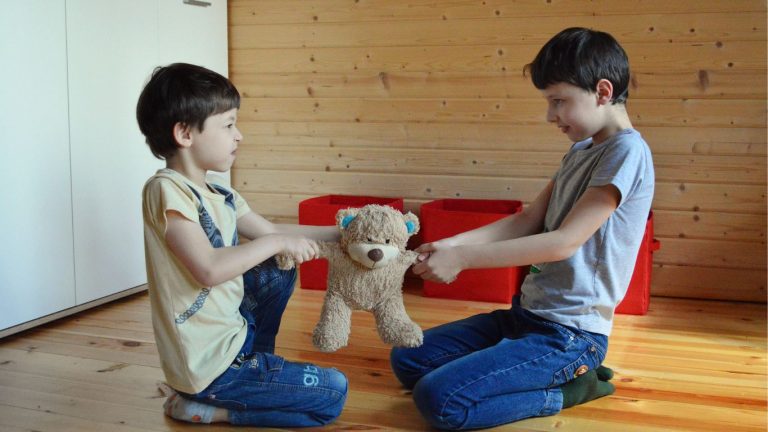Understanding how to get a 5-year-old to listen can be a challenging but rewarding aspect of parenting. At this developmental stage, children are honing their skills in listening, learning, and understanding, yet they have their own priorities and ways of perceiving the world. This step-by-step guide aims to provide parents with effective strategies to communicate with their children, encourage good behaviour, establish consistent routines, and foster independence, all while ensuring that the child feels heard and respected.
Note: We learned (and tested) the majority of these tips from my good friend and parenting expert Amy McCready.
Key Takeaways
- Establish a connection with your child before giving instructions to ensure they are attentive and receptive.
- Communicate with brevity and clarity to keep your child’s attention and make your expectations understood.
- Create an environment where your child can express themselves freely, without fear of judgement, to encourage open communication.
- Set consistent and non-negotiable boundaries while being mindful of your child’s developmental capabilities and milestones.
- Encourage your child’s independence by guiding them through daily tasks and responsibilities, and reinforce positive behaviour with praise.
Establishing Effective Communication
1. Get Your Child’s Attention
Getting your little one to tune in before you start chatting is key. Don’t dive into your spiel until you’ve got those twinkling eyes locked on you. It’s a bit like waiting for the green light before you drive off – you wouldn’t go on red, would you?
So, here’s a cheeky little trick I use: I get down to their level, make a funny face or a silly sound, and just like that, I’ve got their full attention.
Once you’ve got their gaze, keep it simple. A gentle “Can I tell you something?” works wonders. It’s like magic when they pause, look up, and actually listen. And, oh, the joy when they start doing the same to get your attention – it’s a two-way street, after all.
- Make eye contact
- Use their name
- Be patient
2. Be Concise
We’ve all been there, haven’t we? Midway through explaining something to our little ones, we catch that glazed look in their eyes and realise we’ve lost them. Keeping it short and sweet is key. Use as few words as possible when giving instructions. For example, instead of a long-winded explanation about why coats belong on hooks, a simple, “Jacket please, Julia!” with a smile does wonders. Stand there, pointing and smiling, until she takes action.
- Calm yourself.
- Connect.
- Engage cooperation with empathy.
These are the golden rules, really. It’s about striking that balance between being direct and nurturing a positive connection. And remember, it’s not just about what we say, but how we say it. A playful invitation to cooperate, like, “Bath time, Sweetie! Now or in five minutes?” can make all the difference.
We’re not running a military camp, are we? So let’s pare down our orders to what’s truly non-negotiable. It’s about quality over quantity – making each interaction count without overwhelming our little ones with commands.
And when they do listen and act, let’s make a fuss in the right way. Celebrate those achievements, no matter how small. It’s about encouragement, not just compliance. After all, we’re nurturing future adults, not just ticking off a to-do list.
3. Create a Judgement-Free Zone for Sharing
Creating a space where our little ones feel comfortable to share their thoughts and feelings is like laying the bricks for a strong, collaborative relationship. It’s about letting them know that their voice is valued and that it’s okay to express themselves without fear of being dismissed or reprimanded.
By fostering an environment where they can speak freely, we’re teaching them that their opinions and emotions are important. This doesn’t mean we always have to agree with what they say, but it’s crucial to acknowledge their perspective. I remember when my little Charlie came to me, upset about a squabble with a friend. Instead of jumping to conclusions, we sat down and I simply listened. It turned out to be a valuable lesson in empathy for both of us.
When we help our children slow down, explore possibilities, and make informed decisions, we’re doing more than resolving a current issue. We’re empowering them with the ability to handle future dilemmas independently.
Encouraging our children to be open isn’t just about them talking; it’s a two-way street. We need to be just as open and honest in return. This mutual respect paves the way for a deeper understanding and connection. And remember, it’s not about having all the answers—it’s about being there, side by side, figuring it out together.
Understanding and Responding to Behaviour
4. Decipher the Reasons Behind Actions
When our little ones act out, it’s like they’re trying to tell us something in their own language. And it’s our job, as mums, to become fluent in it. Deciphering the reasons behind actions is a bit like detective work, but instead of looking for clues in a mystery novel, we’re tuning into our child’s world. Are they tired, hungry, or overwhelmed? Maybe they’re just trying to assert a bit of independence. It’s all about getting that insight into what’s driving their behaviour.
For instance, my little Charlie once threw his toy car across the room. Instead of just telling him off, I asked him to help me understand why he did it. Turns out, he was frustrated because he couldn’t get the wheels to turn. That moment of frustration was a big reason for his negative behaviour, and it was a chance for me to teach him about expressing emotions in a healthier way.
We all want our children to behave, but good behaviour isn’t just about following rules; it’s about understanding and managing emotions. When we get why they’re acting a certain way, we can guide them towards more positive actions. It’s not just about the immediate situation, but about building predictability and trust for the future. Just like the Child Mind Institute suggests, a consistent and predictable way to respond helps our kids learn what to expect from us and what we expect from them.
It’s not always easy, and sometimes you might feel like you’re not making progress. But hang in there, because every little chat and every shared moment adds up to a big difference in how they learn to express themselves.
Remember, every child is unique, and what works for one might not work for another. But with a bit of patience and a lot of love, we can help our little ones learn to communicate their needs and emotions in a way that sets them up for a lifetime of good behaviour.
5. Set Clear and Non-Negotiable Boundaries
When it comes to raising little ones, setting clear and non-negotiable boundaries is a bit like drawing a map for them. It shows them where they can roam freely and where the ‘no-go’ zones are. Think of it as creating a safe playground within which they can explore, learn, and grow.
It’s all about balance, isn’t it? Too many rules can feel overwhelming, but too few can lead to chaos. That’s why I like to keep a short list of non-negotiables. These are the boundaries that, no matter what, stay put. They’re usually tied to safety, respect, and family values.
For instance, we have a rule that we don’t play with the knobs on the oven. It’s a safety issue, and it’s non-negotiable. When my little one first discovered the joy of turning knobs, I had to be firm and consistent. I explained that it’s dangerous and showed an appropriate way to satisfy his curiosity with toys instead. If he forgets and goes for the oven, I remind him of the rule and the negative consequence that could happen if we don’t follow it.
Here’s a little tip: when you’re dealing with unwanted behaviour, try to redirect it rather than just saying ‘no’. If they’re doing something they shouldn’t, guide them towards something they can do. It turns a potential power struggle into a learning moment.
- Communicate boundaries clearly and consistently.
- Enforce boundaries with appropriate consequences.
- Redirect unwanted behaviour towards positive alternatives.
Remember, boundaries are there to protect and guide our children. They’re not about being the ‘fun police’. By setting these boundaries, we’re teaching our kids how to navigate the world safely and respectfully.
6. Recognise Developmental Milestones
As mums, we’re always on the lookout for those special moments when our kids hit a new milestone. It’s like they have these invisible ‘buttons’ that, once pressed, unlock a whole new level of growth. And let’s be honest, it’s not just about the milestones, it’s about understanding our child’s time and pace.
For instance, my five-year-old recently started tying her own shoelaces, and it was a celebration! It’s these little achievements that show us they’re not so little anymore. Preschoolers are constantly evolving, and it’s our job to keep up! At this age, they’re not just learning to count or recite the alphabet; they’re learning how to navigate emotions and social play.
It’s crucial to engage with them at the child’s level, to ensure we’re not setting the bar too high or too low. Remember how we used to think that 4-year-olds were just about playdough and pretend games? Well, they’re actually soaking up everything around them!
When your child feels heard and understood, it’s like magic. They’re more open to listening and sharing, and that’s when real learning happens. So, let’s celebrate every step, every word, and every little discovery, because these are the signs that our five-year-old is growing up just right.
Building a Foundation for Listening
7. Develop a Consistent Routine
Ah, routines! They’re like the secret sauce to a smoother day with your little ones. Consistency is key, and I’ve found that a solid schedule can work wonders.
When we stick to a routine, it’s not just about keeping things predictable for tomorrow; it’s about setting up a pattern that our kids can rely on day after day. I remember when I first introduced a bedtime routine for my little Charlie. At first, it was a bit of a struggle, but now, he knows that after his bath, it’s story time, and then lights out. It’s become our special time, and he’s ready for bed without any fuss.
Here’s a little list of what a consistent routine might include:
- Wake-up and bedtime at the same time each day
- Regular meal times
- A set time for homework or quiet play
- Scheduled outdoor play
By keeping to a routine, you’re not just managing your child’s expectations; you’re also giving them the framework to manage their own behaviour. It’s about empowering them, gently nudging them towards independence and responsibility. And let’s be honest, it makes our lives as mums a bit easier too!
8. Role-Model Active Listening
As mums, we’re the blockbuster movie stars of our little ones’ worlds, and they’re always ready for the next scene. So, when it comes to teaching good listening skills, we’ve got to be the role models they can look up to. Remember how we hang on to every word of our favourite characters in a movie? That’s the kind of rapt attention we want to inspire in our kids.
By showing them what a good listener looks like, we’re giving them a live demo to follow. It’s like when I’m watching a film with my little one, and they mimic the hero’s every move. They’re not just playing; they’re learning through observation. And it’s the same with listening. If we’re glued to our phones or the telly, we’re sending a message that it’s okay to tune out. But if we put aside our distractions and tune into their audio channel, we’re showing them they’re worth our full attention.
- Listen with your eyes, not just your ears.
- Nod and show understanding.
- Ask questions to clarify and show you’re engaged.
It’s not about being a perfect parent, but about being present. When we actively engage with our children, we’re not just hearing them, we’re listening.
When they’re telling us about their day, or explaining why the living room is a mess, we need to show we’re listening. It’s in these everyday moments that they learn the most. We’re the real role models, and it’s up to us to embody those good listening skills we want to see in our kids.
9. Check for Comprehension
After we’ve chatted with our little ones, it’s crucial to check if they’ve truly grasped what we’ve said. It’s not just about hearing, but understanding. I remember asking my daughter to tidy up her toys before dinner, and she’d nod eagerly but then wander off to the couch, lost in her own world. It dawned on me that she might be hearing, but not processing my words.
To ensure they’ve got it, I often play a little game I like to call ‘Echo Me’. I’ll say something like, ‘After we put away the Lego, we can read your new book from Amazon.’ Then I’ll ask her to repeat the plan back to me. It’s a simple check that can save a lot of repetition and frustration.
We can encourage our children to be more attentive by making comprehension a fun and interactive experience.
Here’s a quick checklist to help you gauge if your child is on the same page:
- Ask them to repeat the instructions back to you.
- Have them explain the task in their own words.
- Use visual aids like a checklist or a schedule.
- Give them a sequence to follow and see if they can do it without prompts.
Remember, every child is different, and some may show signs of being verbally advanced. If your little one is using sentences that are well formed or understands words that describe sequences, like ‘first we go to grandma’s, then the park’, they might just need a bit more of a challenge. Tailor your approach to their level, and you’ll both be happier for it!
Fostering Independence and Responsibility
10. Encourage Self-Reliance in Daily Tasks
As mums, we’re often caught in the whirlwind of doing everything for our little ones, aren’t we? But fostering autonomy in our children is like planting seeds for a garden of self-confidence. It’s about giving them the space to try, fail, and try again, without the fear of judgement or the shadow of our own inability to let go.
Take it from me, the journey to self-reliance starts with the small things. Let’s say your child has just come back from school. Encourage them to hang up their coat and put their lunchbox away. If they only remember the coat, praise them for that! It’s a step in the right direction. And when it’s time for teeth brushing, if they head off but get sidetracked, a gentle nudge back on course is all it takes.
Caregivers, remember that every little effort counts. It’s not about the big leaps, but the small steps that build the path to independence.
Here’s a little list I’ve put together from my own experience and a bit of what I’ve learned along the way:
- Encourage problem-solving by asking open-ended questions.
- Praise the effort, not just the outcome.
- Celebrate the small victories, like hanging up a coat or starting homework.
- Turn everyday tasks into learning opportunities.
By doing this, we’re not just teaching them to listen, we’re teaching them to lead their own little lives with confidence and joy.
11. Guide with Gentle Instructions
When it comes to teaching our little ones, it’s all about balance, isn’t it? We want to guide them, but not to the point where they feel overwhelmed. Gentle instructions are the key, and they’re a cornerstone of respectful parenting. Imagine you’re teaching your child to make their bed. Start with something simple like, ‘Let’s straighten the duvet together,’ and build from there. It’s a bit like how we might approach making an ice cream sundae – one scoop at a time!
Here’s a little tip from my own experience: break tasks down into bite-sized steps. If you’re asking them to tidy up their toys, you might say, ‘First, let’s put the blocks in the box, and then we can sort the cars.’ This way, they don’t feel like they’re facing a mountain of tasks. And remember, courtesy goes a long way. A ‘please’ and ‘thank you’ can make your child feel respected and more inclined to listen.
Sometimes, it’s not about the task at hand, but how we approach it. A gentle nudge in the right direction can make all the difference in nurturing a sense of responsibility.
Lastly, don’t forget to consider your child’s perspective. They might be more interested in drawing than cleaning up. So, why not make it a game? ‘Can you put the toys away before I finish drawing this cat?’ It’s amazing how a little creativity can turn a chore into a fun activity.
12. Praising Efforts and Achievements
As mums, we know that every little victory counts, and praising our children’s efforts can work wonders for their confidence. It’s not about handing out rewards for every little thing; it’s about acknowledging their capabilities and giving positive attention where it’s due. Just the other day, my little one managed to tie her shoelaces all by herself, and the look of pride on her face was priceless! A simple hug and a ‘Well done, love!’ meant the world to her.
Positive reinforcement doesn’t have to be grandiose. Small rewards, like an extra bedtime story or a little extra playtime, can go a long way. It’s about creating a positive relationship, where your child feels valued and motivated to keep trying. And let’s be honest, it’s not just about the children, is it? Seeing their beaming smiles when they’ve accomplished something, it’s a reward for us too, strengthening that strong relationship we cherish.
Avoiding shame and focusing on encouragement helps our children to understand that it’s okay to make mistakes as long as they keep trying. It’s our job to guide them and celebrate the steps they take, no matter how small.
Remember, the goal is to foster independence and a sense of responsibility, not to create a transactional dynamic. By praising their efforts, we’re teaching them to value hard work and to understand that their achievements are something to be proud of.
In Conclusion
As we’ve explored, getting a 5-year-old to listen is less about commanding attention and more about engaging in a two-way street of communication. Remember to connect before you communicate, use fewer words for clarity, and establish a good routine. It’s crucial to understand that children at this age are still learning how to process information and priorities. By listening to them, we model the behaviour we expect in return. So, next time you’re trying to get your little one to put on their jacket or brush their teeth, take a moment to ensure you have their full attention and that they understand what’s being asked. With patience and practise, you’ll find that your child is more receptive and that your instructions are met with the action you’re hoping for.
Note: We learned (and tested) the majority of these tips from my good friend and parenting expert Amy McCready.
Frequently Asked Questions
How do I ensure my 5-year-old is paying attention before I start talking?
Connect with your child before you start speaking. You can’t expect to get through by shouting instructions from across the room. Wait until your child makes eye contact, or ask a question like ‘Can I tell you something?’ to secure their attention.
What can I do to make my instructions more effective for my child?
Be concise with your words. Use as few words as possible and be clear about what you’re asking. For example, you could say ‘Julia! Jacket please!’ and point to the item, maintaining a warm smile until she takes action.
How can I create an environment where my child feels comfortable sharing with me?
Establish a judgement-free zone where your child can speak freely. Choose a quiet place where you can sit together, and allow your child to express themselves without fear of judgement or immediate correction.
What are some non-negotiable boundaries I should set for my 5-year-old?
Identify essential rules that are non-negotiable, such as safety measures and respect for others. Be clear and consistent about these boundaries, and ensure your child understands the importance of following them.
How can I help my child develop good listening habits?
Role-model active listening by giving your child your full attention when they speak to you. Develop a consistent routine that includes time for conversation and checking for comprehension to reinforce good listening skills.
What self-reliance skills should a 5-year-old have?
By age 5, children should start to perform tasks like brushing their teeth, dressing themselves, and tidying up with some guidance. Encourage these skills by giving gentle instructions and praising their efforts to foster independence.





